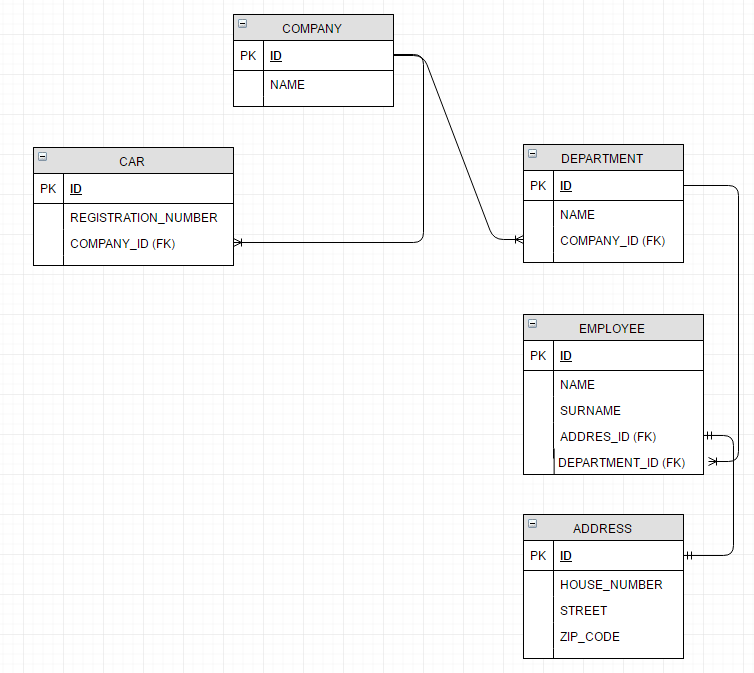Spring Boot + Hibernate Ehcache 
Example Spring Boot + Hibernate + Ehcache project for demonstration purposes of cache mechanism.
Getting started
Prerequisites:
- Java 8
- Maven
- H2/PostgreSQL
It is possible to run application in one of two profiles:
- h2
- postgres
depending on database engine chose for testing.
To enable cache statistics dev profile needs to be turned on.
Testing database schema
Configuration
Cache regions are configured via ehcache.xml file. Following regions are defined:
- companies by id
<cache name="company.byId"
maxElementsInMemory="10000" eternal="false" timeToIdleSeconds="600"
timeToLiveSeconds="3600" overflowToDisk="true"/>- companies by name
<cache name="company.byName"
maxElementsInMemory="10000" eternal="false" timeToIdleSeconds="600"
timeToLiveSeconds="3600" overflowToDisk="true"/>To enable cache mechanism @EnableCaching annotation is added to configuration class. Cache beans are created via annotation:
@Configuration
@EnableCaching
public class CacheConfiguration {
@Bean
public EhCacheManagerFactoryBean ehCacheManagerFactory() {
EhCacheManagerFactoryBean cacheManagerFactoryBean = new EhCacheManagerFactoryBean();
cacheManagerFactoryBean.setConfigLocation(new ClassPathResource("ehcache.xml"));
cacheManagerFactoryBean.setShared(true);
return cacheManagerFactoryBean;
}
@Bean
public EhCacheCacheManager ehCacheCacheManager() {
EhCacheCacheManager cacheManager = new EhCacheCacheManager();
cacheManager.setCacheManager(ehCacheManagerFactory().getObject());
cacheManager.setTransactionAware(true);
return cacheManager;
}
}Implementation
Caching rules are defined in CompanyRepository implementation:
- cache creation
@Cacheable(value = "company.byId", key = "#id", unless = "#result != null and #result.name.toUpperCase().startsWith('TEST')")
public Company find(Long id) {
CriteriaBuilder builder = entityManager.getCriteriaBuilder();
CriteriaQuery<Company> query = builder.createQuery(Company.class);
Root<Company> root = query.from(Company.class);
root.fetch(Company_.cars, JoinType.LEFT);
Fetch<Company, Department> departmentFetch = root.fetch(Company_.departments, JoinType.LEFT);
Fetch<Department, Employee> employeeFetch = departmentFetch.fetch(Department_.employees, JoinType.LEFT);
employeeFetch.fetch(Employee_.address, JoinType.LEFT);
departmentFetch.fetch(Department_.offices, JoinType.LEFT);
query.select(root).distinct(true);
Predicate idPredicate = builder.equal(root.get(Company_.id), id);
query.where(builder.and(idPredicate));
return DataAccessUtils.singleResult(entityManager.createQuery(query).getResultList());
}
@Cacheable(value = "company.byName", key = "#name", unless = "#name != null and #name.toUpperCase().startsWith('TEST')")
public Company find(String name) {
CriteriaBuilder builder = entityManager.getCriteriaBuilder();
CriteriaQuery<Company> query = builder.createQuery(Company.class);
Root<Company> root = query.from(Company.class);
root.fetch(Company_.cars, JoinType.LEFT);
Fetch<Company, Department> departmentFetch = root.fetch(Company_.departments, JoinType.LEFT);
Fetch<Department, Employee> employeeFetch = departmentFetch.fetch(Department_.employees, JoinType.LEFT);
employeeFetch.fetch(Employee_.address, JoinType.LEFT);
departmentFetch.fetch(Department_.offices, JoinType.LEFT);
query.select(root).distinct(true);
Predicate idPredicate = builder.equal(root.get(Company_.name), name);
query.where(builder.and(idPredicate));
return DataAccessUtils.singleResult(entityManager.createQuery(query).getResultList());
}- cache invalidation
@Caching(evict = {@CacheEvict(value = "company.byId", key = "#company.id"), @CacheEvict(value = "company.byName", key = "#company.name")})
public void delete(Company company) {
entityManager.remove(company);
}- cache update
@Caching(evict = {@CacheEvict(value = "company.byName", allEntries = true)},
put = {@CachePut(value = "company.byId", key = "#result.id", unless = "#result != null and #result.name.toUpperCase().startsWith('TEST')")})
public Company update(Company company) {
return entityManager.merge(company);
}Cache statistics
Optionally it's possible to expose MBean to gather cache statistics:
@Bean
public MBeanServer mBeanServer() {
MBeanServer mBeanServer = ManagementFactory.getPlatformMBeanServer();
return mBeanServer;
}
@Bean
public ManagementService managementService() {
ManagementService managementService = new ManagementService(ehCacheCacheManager.getCacheManager(), mBeanServer(), true, true, true, true);
managementService.init();
return managementService;
}